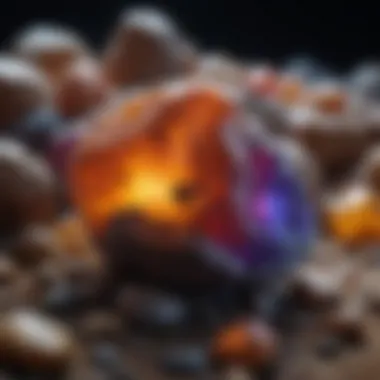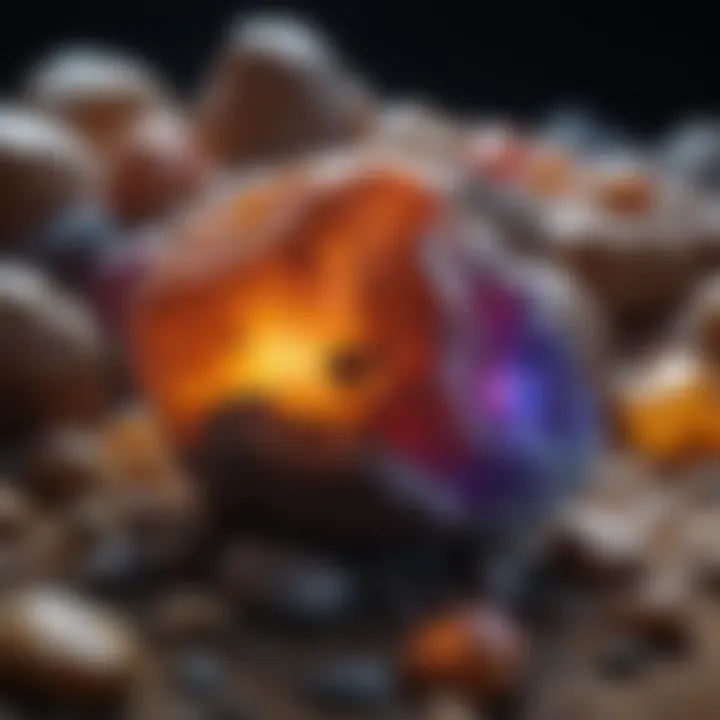Exploring the Fascinating World of Luminous Rocks


Intro
The study of luminous rocks shines a light on a captivating intersection of geology, science, and culture. From the sandy shores of Brazil to the icy peaks of the Himalayas, luminous rocks have intrigued humans across different ages and milieus, creating a narrative filled with wonder and inquiry. These natural marvels emit light in various ways, making them both a scientific curiosity and a cherished collectible.
In this exploration, we’ll unravel the layers surrounding these geological phenomena, understanding not just how they glow, but also their historical and cultural significance. We'll investigate the types of luminous rocks, their origins, and the scientific principles at play when these rocks light up the darkness. By delving into both natural occurrences and human enhancements, we provide a holistic view that appeals to both enthusiasts and collectors alike.
Through this article, we aim to bridge the gap between knowledge and appreciation for these unique rocks. The narrative will also discuss gathering techniques and identification methods to help collectors discern glowing gems from ordinary stones. We're about to embark on a journey that enhances our understanding and appreciation of these geological wonders.
Prologue to Luminous Rocks
The study of luminous rocks captivates those who seek to understand the marvels of nature. These fascinating geological formations possess the ability to emit light, creating a spectacle that draws both curiosity and admiration. Understanding luminous rocks enhances our appreciation for the natural world and emphasizes the intricate relationships between geology, physics, and cultural heritage.
Luminous rocks can be segregated into various categories based on their properties, such as fluorescent, phosphorescent, and bioluminescent. Each type holds distinct significance and curiosity that merits exploration. The characteristics and contexts surrounding these rocks provide fruitful discussions about their roles in both scientific inquiry and artistic expression.
Defining Luminous Rocks
Luminous rocks, in essence, are geological materials that can emit light, often under specific conditions. This characteristic can arise from various mechanisms, including fluorescence and phosphorescence. The allure of these rocks typically lies in their bright colors and patterns that catch the eye, evoking wonder and sparking imagination.
The phenomena of luminescence can be linked to intrinsic properties like the crystal structure of certain minerals, their chemical composition, and the environmental conditions where they are found. Some rocks can glow brightly when exposed to ultraviolet light, while others may maintain a soft glow in the absence of light. This ability to shift between visibility states offers a unique aspect of study and enjoyment for collectors and enthusiasts.
Historical Context
Early Discoveries
The historical journey of luminous rocks dates back centuries. Early human encounters with glowing minerals likely sparked lore and fascination. For instance, ancient civilizations stumbled upon rocks that glowed when night fell or when struck by light. Notable among these early discoveries was the identification of certain minerals in caves, like calcite, which displayed photoluminescent properties. This had a ripple effect, captivating scholars and igniting interest in scientific investigation.
Key figures in science, such as Sir Isaac Newton, touched upon these phenomena in their explorations of light and optics. The study of luminous materials has since evolved into a significant area of research, contributing immensely to our understanding of physical sciences. With these developments, the initial raw wonder transformed into structured scientific inquiry, forever changing our approach towards such geological wonders.
Cultural Significance in Antiquity
The cultural narratives surrounding luminous rocks have also made their mark in history. Many ancient cultures intertwined geological findings with their mythologies. For example, the Egyptians revered certain glowing minerals, attributing them magical properties or divine messages. Such belief systems often reflected a deeper connection to their environment, as these rocks represented the earth’s gifts.
Moreover, the identification of specific luminous minerals played an essential role in ancient art and architecture. The intricate designs infused with glowing elements enhanced their spiritual and aesthetic value. As a result, these materials became indispensable in ceremonial artifacts and sacred spaces.
In summary, exploring luminous rocks through history sheds light on humanity's relationship with the natural world. This examination not only enriches our understanding of geological phenomena but also highlights the enduring connection between these rocks and the cultural narratives that accompany them.
Types of Luminous Rocks
The exploration of luminous rocks is more than just a glance at their glow; it opens up a fascinating window into geological wonders that combine science with artistry. Types of luminous rocks play a crucial role in understanding both the natural worlds from which they spring and the ways they are transformed for human use, appreciation, and application. It is the diversity in types that offers collectors, enthusiasts, and researchers a richer perspective on these stones.
Fluorescent Minerals
Characteristics and Examples
Fluorescent minerals are a type of luminescent rock that exhibits unique behaviors under ultraviolet (UV) light. The key characteristic of these minerals is their ability to absorb UV light and re-emit it as visible light almost immediately. A common example is fluorite, which can exhibit a vibrant green or purple glow. When illuminated with UV light, it becomes a dazzling spectacle. This immediate reaction to UV light is what makes fluorescent minerals a popular choice among collectors. Their visual drama adds a layer of appeal, not just scientifically but also aesthetically.
One could say that the allure of fluorescent minerals lies in their playful nature, revealing hidden colors and patterns that are otherwise invisible. Collectors appreciate them not only for the glow, but also for the intricate varieties—like calcite that may shine bright orange or scheelite that glimmers blue. However, the primary downside is that exposure to sunlight or certain wavelengths may fade their luminescence over time, requiring careful handling to maintain their brilliance.
Common Locations
Fluorescent minerals are often found in distinct geological settings. Notable mining sites, such as the Franklin and Ogdensburg areas in New Jersey, are renowned for their rich deposits. The key feature of these locations is the unique geological formations that foster the development of minerals possessingfluorescent properties. Collectors often flock to these areas, making it a culturally significant hub.
However, a unique aspect of such locations is that they are not only sites for extraction but also for education, drawing thousands curious about the intersection of geology and visual art. The challenge lies in acquiring specimens—competition can be fierce, and navigating land ownership adds complexity for those looking to dig their own.
Phosphorescent Minerals


Difference from Fluorescence
Phosphorescent minerals are often compared to their fluorescent cousins but differ in a significant way; they can store energy and emit light for a more extended period, even after the stimulating light source is removed. Notable for their afterglow, phosphorescent materials, such as zinc sulfide, demonstrate a fascinating property known as delayed luminescence. This quality heightens their desirability as collectors' items because they offer not just a momentary display but a lasting visual effect.
While this ability makes them compelling, it is also accompanied by a limitation: the intensity and duration of their glow can be influenced by the environmental conditions, such as temperature and humidity.
Examples and Uses
Some prominent examples of phosphorescent minerals include strontium aluminate and certain forms of barite. Their practicality extends beyond mere aesthetics; phosphorescent compounds are employed in various applications, from safety signage to glow-in-the-dark materials. Collectors find great value in these minerals for their dual roles—scientific interest and practical utility. Adding them to collections isn’t just a whim; it’s often backed by strong aesthetic or functional motives. However, the challenge remains in sourcing quality specimens that possess this unique afterglow usability without compromising their natural beauty.
Bioluminescent Structures
Nature’s Own Illumination
Bioluminescent structures are nature’s own version of glow, where life itself emits light. This group includes certain fungi and the bioluminescent minerals that might contain living organisms. Unlike the previous types, bioluminescence is biologically driven and involves chemical reactions within the living organism, a phenomenon that’s predominantly seen in deep-sea species or specific terrestrial fungi. This characteristic of self-generated light, derived from the biological makeup, captures a different slice of the luminous rock phenomenon.
Many enthusiasts find this aspect both intriguing and educational as it highlights the complexity of ecosystems. The interplay of living organisms and minerals introduces a layer of ecological significance that is not typically present in inanimate luminous rocks. However, a disadvantage is that such materials might be more vulnerable to environmental changes compared to more stable mineral counterparts.
Specific Examples in Geology
Specific geological instances, such as the glowing fungi found on decaying wood or the fluorescent moss in certain caves, showcase bioluminescence in unique ecosystems. Such instances enhance our understanding of both geology and biology, making them valuable educational tools as well as collectible marvels. Each example reveals different biological processes and their geological implications, further enriching the narrative of luminous rocks. Naturally, the ephemeral nature of life means collectors often seek these specimens with a sense of urgency, posing both a challenge and an opportunity for appreciation and study.
Mechanisms of Luminescence
The study of luminous rocks hinges significantly on the mechanisms that give rise to their unique glowing properties. Understanding these mechanisms not only enriches our knowledge but also informs various practical applications ranging from art to industry. Essentially, the ability of certain minerals to emit light—either naturally or through artificial enhancement—plays a crucial role in the fascination surrounding these geological formations. By delving into the science behind luminescence and the methods of artificially enhancing these qualities, we can appreciate the multifaceted nature of luminous rocks.
The Science Behind Luminescence
Electromagnetic Radiation and Energy Absorption
One pivotal aspect of luminescence is the interaction between electromagnetic radiation and energy absorption. The process begins when minerals absorb energy from various sources, whether it be ultraviolet light or other forms of electromagnetic radiation. Upon absorbing this energy, certain electrons in the mineral become excited and move to a higher energy state. When these electrons return to their original state, they release energy in the form of light.
A key characteristic of this phenomenon is its dependence on the type of electromagnetic radiation absorbed. For instance, some fluorescent minerals, like fluorite, are particularly sensitive to UV rays, making them appear vividly bright under a black light. This unique feature of energy absorption is beneficial in environments that utilize UV light for a dramatic visual impact, especially in artistic settings where color and luminance play pivotal roles. However, one must consider that sustained exposure to high levels of ultraviolet radiation can lead to degradation of certain minerals, which poses a disadvantage in long-term applications.
Chemical Processes in Rocks
Chemical processes also contribute significantly to luminescence in rocks. Various minerals contain specific elements that can alter their luminescent properties. For example, the presence of certain trace metals—like manganese or europium—can create characteristic colors and intensities in luminescent minerals. Each chemical interaction can lead to different luminescent effects, depending on the unique composition of the mineral.
An important trait of these chemical processes is their ability to produce consistent qualities in luminous rocks, which is invaluable for collectors and researchers alike. The predictability of chemical luminescence can guide explorers and scientists in identifying potential specimens with desirable properties. However, the variability in chemical makeup can also create inconsistencies in glow characteristics, which may present challenges when attempting to monetize or market these minerals effectively.
Artificial Enhancement Techniques
Treatments and Chemicals
The realm of luminous rocks extends into the art of enhancement, where various treatments and chemicals are applied to amplify their glowing properties. For instance, some minerals undergo processes like doping, where specific elements are introduced to increase luminescence.
A noteworthy aspect of these enhancement techniques is their ability to transform relatively mundane rocks into striking pieces of art, appealing to both the aesthetic senses and scientific curiosities. Collectors benefit greatly from these techniques, as they increase the value and visual appeal of their specimens. However, it is essential to maintain ethical standards in treatments, as misrepresentation can hinder trust in the collector community.
Artist Engagement with Luminous Rocks
Artists have found a vibrant playground in luminous rocks, utilizing their properties creatively in various mediums. From sculptures that glow softly in the dark to paintings infused with luminescent minerals, the engagement between artists and these geological wonders invites a fresh perspective on both art and science. This dialogue fosters innovation, pushing artists to experiment with incorporating these natural phenomena into their work, ultimately enriching the artistic landscape.
A distinct feature of artist engagement with luminous rocks is the blending of natural and fabricated designs, where the raw beauty of the earth harmonizes with human creativity. While this collaboration opens new pathways for artistic expression, it also invites a discussion about authenticity versus enhancement, a significant consideration for both artists and collectors alike.
Applications of Luminous Rocks
The applications of luminous rocks extend far beyond mere aesthetic appeal, carving out distinct niches in various fields such as art, design, science, and industry. These geological treasures provide unique value, intricately linking natural phenomena with human creativity and technological advancement. It's fascinating to explore how luminescent minerals are utilized, enhancing both functional and decorative elements in our daily lives.


In Art and Design
Artistic Innovations
When artists choose luminous rocks as part of their mediums, they tap into a wellspring of creativity that fuses science with emotion. Artistic innovations arising from these materials create mesmerizing artworks that capture light in dynamic ways. For instance, artists often use phosphorescent minerals to create pieces that change appearance as lighting conditions shift. This is a key reason many contemporary creators are drawn to them; the interaction between light and these materials adds an engaging layer to the artwork.
A notable example is the work of contemporary artists who incorporate minerals like strontium aluminate in their sculptures. These rocks store light and slowly release it, leading to unique visual experiences. However, one must consider the challenges of integrating these materials, such as sourcing genuine specimens and understanding their chemical properties, which can complicate the artistic process and impact the final piece's durability.
Interior Design Trends
In the realm of interior design, luminous rocks are carving out their space. Designers lean toward using these materials in innovative ways, such as embedding glow-in-the-dark minerals in flooring or wall installations. The aesthetic character they bring is striking, often regarded as a conversation starter for any space. The soft, warm glow can create enchanting atmospheres, making spaces feel otherworldly and inviting.
A unique feature of this trend is the practicality of luminous rocks. They can serve as both functional and decorative elements within homes or commercial spaces. For instance, rocks like calcite can accentuate pathways or staircases, providing guidance without the necessity of artificial light. However, one downside is the potential for fading, whereby continual exposure to strong light can diminish their luminescent properties over time, prompting a need for consideration in design choices.
In Science and Industry
Mineral Exploration
Luminous rocks hold substantial importance in mineral exploration. The unique characteristics of certain luminescent minerals can serve as indicators of other mineral deposits. Geologists often utilize the glow of specific minerals, such as willemite, to target areas rich in strontium or zinc, thus enhancing exploration efforts.
The key aspect that makes luminous rocks vital in this field is their ability to be detected under ultraviolet lights, facilitating the identification of various geological formations without invasive methods. This increases efficiency and reduces the environmental footprint of mining activities. However, reliance on these markers necessitates an understanding of local geology to preventing misinterpretations and wasted resources.
Technological Applications
Technological applications of luminous rocks extend into realms such as electronics and displays. As researchers continuously innovate, some luminous minerals are being harnessed for their optical properties, leading to advancements in lighting solutions and screens.
One remarkable quality is that these materials can be combined with plastics and quartz to create products like luminescent paints and coatings, which are increasingly used in safety applications, road markings, or even consumer electronics. While the potential is vast, challenges remain, such as maximizing luminescence efficiency while minimizing the toxicity of certain chemicals involved in these applications. Understanding these nuances becomes crucial as industries look to integrate these beautiful yet perplexing materials.
Collecting Luminous Rocks
Collecting luminous rocks is an endeavor that captivates many enthusiasts and curators alike. These geological marvels not only shed light—quite literally—on the beauty of nature but also represent a fascinating intersection of science and art. Each specimen has a story to tell, revealing details about its origin, properties, and the processes that led to its luminescence. For collectors, this process becomes a journey, one of discovery and connection to the natural world.
Best Practices for Collectors
When immersing oneself in the world of luminous rock collecting, it’s vital to adopt best practices that ensure both authenticity and preservation.
Identifying Authenticity
Identifying authenticity in luminous rocks is crucial for any serious collector. It’s about knowing not just what to look for but understanding the geological background of each piece. A key characteristic of authenticity in this context is the rock's natural luminescent properties—the way it interacts with light.
Why is this important? Genuine specimens provide valuable insight into the mineral composition and the geological processes that formed them. For instance, a real bowling ball-sized piece of quartz that glows under ultraviolet light is vastly different from an imitation painted with fluorescent paint.
Collectors often look for unique features like proper crystallization, internal fractures, and even the presence of associated minerals to determine the authenticity. Techniques like comparing under UV light or utilizing a pocket refractometer can enlighten a collector about the properties of their specimen. On the downside, if one cannot spot the difference, it could lead to frustration and a loss financially.
Preservation Techniques
The preservation of luminous rocks should not be underestimated. Proper preservation techniques maintain the integrity of the natural luminescent properties while safeguarding these treasures for the future. One of the key aspects here is temperature and humidity control. Luminous rocks can easily be affected by environmental changes, which may result in degradation.
For many collectors, storing pieces in climate-controlled environments or utilizing display cases that protect from UV light is a favored choice. This not only helps retain the luminescence but also keeps the rock in pristine condition, prolonging its life. Additionally, careful handling is paramount, as some minerals can be sensitive to oils or dirt from human hands. The downside? Such precautions require knowledge and often a bit of investment in the right materials to ensure successful preservation.
Market Trends and Value Assessment
As one's collection grows, so does the need to understand market trends and assess the value of luminous rocks. This aspect is essential for both new and seasoned collectors looking to expand their holdings or simply understand what they’ve accumulated.
Evaluating Worth
When it comes to evaluating worth, various factors play a crucial role. One significant characteristic is rarity. Luminous mineral samples, such as particular specimens of willemite or scheelite, can offer higher return value due to their scarcity and desirability among collectors.


Additionally, the provenance of each rock can greatly enhance its worth; a well-documented history of a specimen adds layers of value that mere appearance cannot provide. However, evaluations can sometimes lean subjective, dependent on personal bias and market trends that fluctuate like the tides. Thus, understanding these dynamics can substantially benefit collectors who want to make informed decisions.
Trading and Selling
Trading and selling luminous rocks is an exciting part of being a collector but requires caution. The key characteristic here is understanding the marketplace. Various online platforms, forums, and trade shows cater to collectors eager to buy, sell, or trade gems. Social media platforms like Facebook groups or dedicated Reddit communities can also facilitate these interactions.
Unique features, such as being able to highlight the specimen’s history and authenticity effectively, can make a selling point stronger. However, inexperienced sellers might find themselves facing challenges like pricing wars or misleading representations from buyers. Therefore, knowledge about the rocks and current market values is paramount for successful transactions.
"Collecting luminous rocks isn’t just about gathering specimens; it’s about sharing stories and fostering connections with the natural world."
In summary, embarking on the journey of collecting luminous rocks calls for an understanding of authenticity and preservation, alongside an awareness of market trends and trading practices. Embracing these aspects will enhance the collecting experience, ensuring that both nostalgia and knowledge shine through.
Cultural and Beyond
Cultural perspectives on luminous rocks offer a rich tapestry of narratives that add depth to our understanding of these fascinating geological entities. This focus on cultural significance situates luminous rocks not just in the realm of natural history but also in human history. By examining how various cultures have interpreted and integrated these glowing minerals into their beliefs, rituals, and practices, we bridge the gap between science and art, highlighting the multifaceted roles these rocks play in societies worldwide.
Luminous Rocks in Folklore
Legends and Myths
Beliefs surrounding luminous rocks have seeped into the collective consciousness and folklore of numerous civilizations. Many of these legends often ascribe intrinsic powers to these rocks, suggesting a direct relationship between the luminescence and divine intervention. In some Native American cultures, glowing stones are considered as protective talismans, thought to be imbued with sacred wisdom. This deep connection lends spiritual depth and significance to luminous rocks, as they transform into more than mere geological samples and take on roles as cultural artifacts.
The enchanting nature of these legends makes them an engaging choice for exploration in this article. They showcase how humans have always sought to explain the unexplainable and find meaning in the natural world. The unique feature of these myths is their ability to connect generations, where stories are passed down, instilling a sense of wonder among those who hear them. However, one limitation in this area is the risk of over-romanticizing these narratives without grounding them in scientific understanding, which could mislead readers.
Spiritual Significance
Luminous rocks are often linked with spiritual practices and beliefs, offering a confluence of science and spirituality. The glow they emit is sometimes perceived as a reflection of enlightenment or a connection to higher realms. In certain traditions, holding a luminescent mineral in meditation is thought to enhance the individual's awareness and open channels to spiritual insights. This perspective highlights an essential characteristic of these rocks—their ability to inspire introspection.
The spiritual significance of luminous rocks makes them a compelling addition to this article. They embody a bridge between tangible geology and intangible human experience. Their unique feature lies in their capacity to evoke awe and serenity, providing comfort or guidance to those who seek it. A potential drawback, however, could arise if the focus leans too heavily on the spiritual at the expense of the scientific aspects, thereby alienating readers seeking a more rational exploration of luminous phenomena.
Future of Luminous Rocks Research
Emerging Technologies
The future of research into luminous rocks stands on the cusp of rapid advancements thanks to emerging technologies. Innovations in spectroscopy and imaging techniques enable scientists to better analyze and understand the luminescence phenomena occurring in these minerals. For instance, advanced imaging can reveal the microstructure and chemical composition responsible for their glowing characteristics, bringing fresh insights into their formation and potential applications.
This innovative approach is essential to this article, as it conveys not only the scientific rigor involved in studying luminous rocks but also opens doors for practical applications that might stem from this knowledge. A unique aspect here is how emerging technologies can interact with traditional methods, offering enhanced tools while respecting age-old practices in mineral collection and study. A downside, though, could be the complexity of such technologies, which may alienate amateur collectors or those less versed in scientific techniques.
Potential Discoveries
The realm of luminous rock research is rich with the promise of potential discoveries that could reshape our understanding not just of geology, but also of ancient human interactions with these materials. Ongoing exploration might lead to the unearthing of new minerals or unexplained luminescent properties that haven’t been thoroughly documented.
This aspect of potential discoveries excites the narrative of this article. It instills a notion of continuous learning and re-discovery, reminding readers that the story of luminous rocks isn’t finished. The unique characteristic of this pursuit is its inherent unpredictability; new findings can drastically alter existing knowledge frameworks. Although the anticipation of potential discoveries is thrilling, it's essential to temper expectations—while some discoveries might yield groundbreaking insights, others could prove less revolutionary, reminding us of the nature of scientific inquiry itself.
"The glow of a rock can tell a story far beyond its physical form, embodying the light of civilization’s deepest questions and inspirations."
Such perspectives on luminous rocks not only enrich individual understanding but also highlight their importance in our cultural heritage and future explorations.
Culmination
The exploration of luminous rocks offers a unique perspective on the interconnectedness of natural beauty and scientific wonder. Engaging with this topic allows enthusiasts and collectors to step beyond traditional boundaries of geology and dive into a world where light, both natural and enhanced, plays a pivotal role. The findings presented throughout this article emphasize the multifaceted nature of luminous rocks, showcasing their scientific significance and their artistic appeal.
Reflecting on the Journey
As we wind down our exploration, it's crucial to contemplate the journey we've taken through the vibrant world of luminous rocks. From the earliest human encounters to contemporary innovations in art and design, the trajectory of our understanding has been rich. Each discovery and each story traced back through history contributes significantly to the knowledge we possess today. Not just geological specimens, these luminous formations evoke emotional and cultural responses, reflecting deep-rooted connections to the earth itself. The luminescence in these rocks transcends mere physical property; it becomes a narrative of time, light, and space—a unique language that speaks to collectors, artists, and scientists alike.
Invitation to Explore
Now, dear reader, as you stand on the edge of this magnificent realm, consider this an invitation. Venture into the world of luminous rocks not just as passive observers but as active participants. Attend exhibitions where the flares of these natural wonders dazzle, connect with fellow enthusiasts who share your passion, and explore the landscapes where these geological treasures lie. Whether you’re a seasoned collector or a curious newcomer, embracing this journey opens doors to endless possibilities. By reaching out and engaging, you can unearth knowledge that often lies hidden beneath the surface. This is more than a hobby—it’s a lifelong adventure that seeks to bridge the worlds of science, culture, and the unseen beauty of nature.
"The glow of a luminous rock is but a reflection of the light we seek in the mysteries of our own existence."
So go ahead, explore. The luminous rocks await your discovery!



